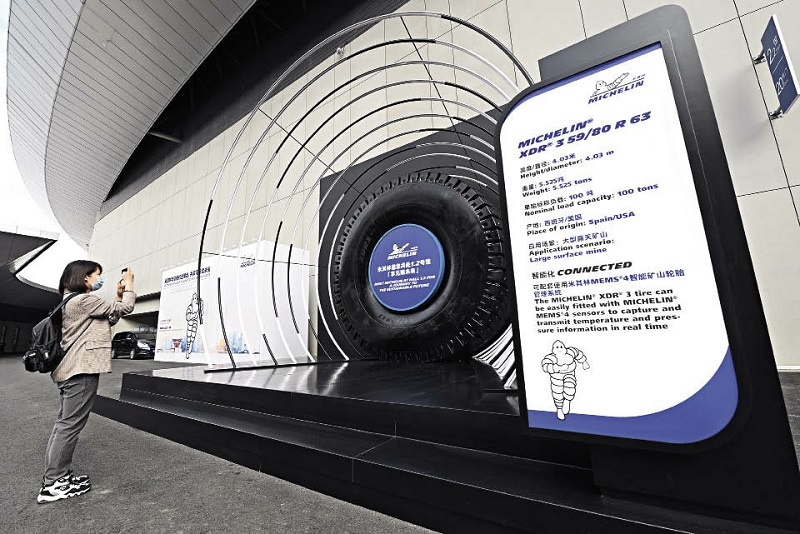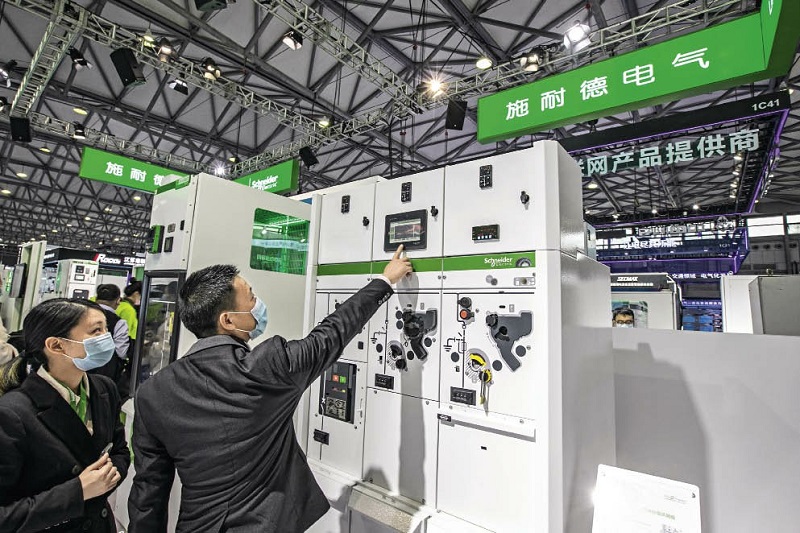On March 11, the Fourth Session of the 13th National People’s Congress (NPC) approved the Outline of the 14th Five-Year Plan for National Economic and Social Development and the Long-Range Objectives Through the Year 2035.
The adoption of this master plan for China to embark on a new journey of building a modern country in all respects is a landmark and has attracted extensive attention both at home and abroad.
Many foreign companies in China are particularly concerned about how the 14th Five-Year Plan will affect their investment and future development here. L’Oreal, Michelin, Schneider Electric, Safran, and Stellantis Group, among others, expressed their expectations for China’s 14th Five-Year Plan and the resulting development opportunities.

A giant Michelin’s XDR 3 tire is on display at the Michelin Group booth at the third China International Import Expo (CIIE) held in Shanghai, on November 5, 2020.
New Prospects for Win-Win Cooperation
On March 1, 10 days before the adoption of the 14th Five-Year Plan, the Ministry of Commerce issued a circular on stabilizing foreign investment for the construction of a new development pattern. According to the circular, China will draw up the 14th Five-Year Plan for the Utilization of Foreign Investment this year, formulate a negative list for cross-border trade in services in pilot free trade zones, further lift restrictions on foreign investment outside the negative list, and ensure the implementation of opening-up measures in the automotive, financial, and other sectors.
Premier Li Keqiang said at a press conference on March 11 that China had proposed to position itself on the new stage of development, implement a new development philosophy and build a new pattern of development with domestic development as the main focus and international and domestic development cycles reinforcing each other. This is not only to expand the domestic market, but also to further open up.
“We will further embrace the outside world, continue to shorten the negative list for foreign investment in China, and promote opening-up, including in the service sector. I have noticed that many foreign companies are concerned about the business environment in China. A market-oriented, law-based, and international business environment will leave them assured,” Li Keqiang said.
Kamran-Charles Vossoughi, president and CEO of Michelin Greater China, cited the shortened negative list for market access and the compilation of the 14th Five-Year Plan for the Utilization of Foreign Investment as the best evidence of China’s continued opening-up in recent years.
He said that the Chinese market has entered a stage of high-quality development and its market potential is being continuously tapped into. Foreign companies will gain broader market access and new development opportunities. “China’s openness and enthusiasm make it easier for foreign companies to invest here, which is a win-win situation for companies, China, and the world,” he said.
Grégoire Olivier, a member of Stellantis’ top executive team and chief operating officer (COO) for China, said that the series of opening-up measures will benefit foreign companies in China. For Stellantis, thanks to favorable policies and support from the Chinese government, it is producing its luxury brand models DS 7 and DS 9 in Shenzhen.
In addition to being sold in China, the DS 9 will also be exported to other markets around the world, including Europe. For Olivier, this is a good example of the cooperation between Chinese and foreign companies under China’s opening-up policy, proving that foreign companies in China are fully entitled to their legal rights.
According to reports, in the automobile industry, China removed the foreign ownership restrictions on special-purpose vehicles and new energy vehicles (NEVs) in 2018. The liberation was extended to commercial vehicles in 2020, and will include passenger vehicles in 2022. In addition, the rules that currently prohibit foreign automakers from setting up more than two joint ventures in China will also be lifted in 2022.
Fabrice Megarbane, L’Oreal’s North Asia president and China CEO, said several measures, including the Foreign Investment Law, which became effective on the first day of 2020, and the establishment of free trade zones, had created a high-quality business environment. Friendly relations between China and the rest of the world are conducive not only to economic and trade cooperation, but also to stimulating innovation, solving global problems, and benefiting consumers.
Philippe Bardol, general delegate for China and chief executive officer of Safran China, welcomed the formulation and implementation of the 14th Five-Year Plan for the Utilization of Foreign Investment. The China-EU Comprehensive Agreement on Investment, which was concluded in principle at the end of last year, will ensure better access for EU investors to China, which boasts a “fast-growing market of 1.4 billion consumers” and fairer environment for competition, he added. Meanwhile, he pointed out that the agreement is conducive to the development of Chinese companies that are already in Europe or have business in Europe.

Equipment made by Schneider Electric on display at the CDCE International Data Center Exhibition on December 3, 2020, in Shanghai.
Green, Low-Carbon Development
The Outline of the 14th Five-Year Plan sets “new progress in ecological civilization” as one of the important goals of economic and social development, charting the course for further implementation of the sustainable development strategy. Christophe Lauras, president of the French Chamber of Commerce and Industry in China, said that there is great room for cooperation between Chinese and French enterprises in sustainable urban development, resource recycling, construction materials, and new energy.
Grégoire Olivier believes that a green economy is a global trend, and China’s strong determination in environmental protection and carbon emission cuts will benefit not only itself, but also the whole world. He said Stellantis Group will closely follow China’s 14th Five-Year Plan and contribute as much as possible to helping China reduce carbon emissions and develop a green economy.
Speaking of L’Oreal’s green development strategy, Fabrice Megarbane proudly said that China is the first market where L’Oreal achieved carbon neutral operations. L’Oreal has also built its first water recycling plant of the Asia-Pacific region in China.
In terms of low carbon, environmental protection and ecological development, Philippe Bardol said that Safran is fully committed to a path of technological innovation to make aviation greener, with 75 percent of its R&D and technology investment having been focused directly or indirectly on reducing the “carbon footprint” of its products.
Kamran-Charles Vossoughi stressed that sustainable development has become a common demand of the state, enterprises, and individuals in China. Michelin is committed to providing consumers with an environmentally friendly solution to travel, energy, and gastronomy through continuous innovation.
Sharing the Dividends of Digital Economy
Today, the digital transformation of the global economy has become a major trend. The 14th Five-Year Plan aims to create new advantages in the digital economy, speed up the pace of building a digital society, improve digital government construction, and create a sound digital ecology.
China’s history of encouraging innovation, a vibrant market, and a startup-friendly ecosystem has attracted a lot of innovative and entrepreneurial talent, according to Megarbane. He believes China will become a global center of innovation and a laboratory of the future. “Thanks to China’s close cooperation with various countries, including France, hi-tech technologies such as 5G, AI, and VR will benefit Chinese and global consumers,” he said.
The Safran aircraft engine plant in Guiyang will be relocated to a new “Industry 4.0” plant by the end of this year, according to Bardol. The new plant will be built according to the group’s highest industrial standards and will employ digital solutions such as collaborative robots and smart data.
“We are deploying our Chinese factories with the smart manufacturing standards of the future’s factories to adapt to the digital transformation of China’s rapidly developing industry,” he said.
Stellantis Group is taking full advantage of China’s leading position in global digitalization by opening multiple R&D centers in China to develop smarter vehicles. Olivier said China is a generation ahead of Europe in 5G technology. In order to adapt to the rapid development of digitalization in China, he added, his company will increase R&D investment in high-end digital technologies.
Pang Xingjian, senior vice president of Schneider Electric, believes that for a foreign company like Schneider Electric, which is rooted in the Chinese market, the 14th Five-Year Plan not only makes its direction clear, but also reassures it to continue to increase investment in the development of digital economy.
Advanced technologies, represented by 5G, AI, and blockchain, have become a powerful driving force for China’s digital economy, Pang said, adding that Schneider will further encourage digital transformation and share the benefits of the digital economy.
ZHANG PINGPING is a reporter with China.org.cn